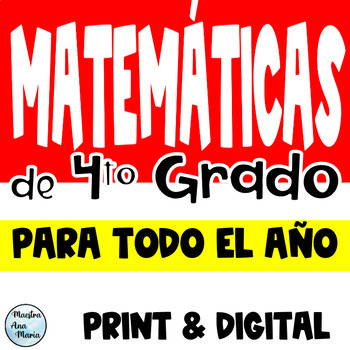Fourth Grade Math in Spanish - Matemáticas de Cuarto Grado
- Zip
- Google Apps™

What educators are saying
Products in this Bundle (5)
Also included in
- Fourth Grade Math in Spanish - Worksheets and posters to complement fourth grade math content. What includes: Fourth grade math assessments for all the Common Core StandardsWord problems - All Operations Differentiated word problemsPostersRecording sheets to keep track of students' progressAnswer KPrice $16.00Original Price $28.80Save $12.80
Description
Ahorra dinero con este bundle de matemáticas para cuarto grado. Con este paquete tendrás actividades para todo el año. Este recurso se basa en los estándares de cuarto grado. Sin embargo, puede usarse para reforzar conceptos en 5º y 6º.
Que incluye:
✏️3 hojas de trabajo para cada estándar de cuarto
✏️Versión digital – Presentaciones interactivas de Google
✏️Carteles
✏️Hojas para registrar el desempeño de los estudiantes
✏️Respuestas
Save money with this Fourth Grade Math Bundle. With this super bundle you will have activities for the whole year. This resource is based on the fourth grade standards. However, it can be used to reinforce concepts in grades 5 and 6.
What includes:
✏️3 worksheets for each standard
✏️Digital version – Interactive Google Slides
✏️Sheets to record students’ performance
✏️Answer key






